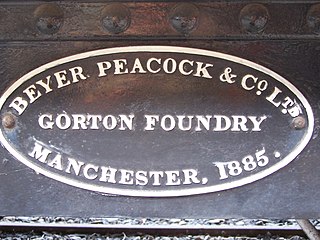Related Research Articles

Under the Whyte notation for the classification of steam locomotives, 4-8-2 represents the wheel arrangement of four leading wheels, eight powered and coupled driving wheels and two trailing wheels. This type of steam locomotive is commonly known as the Mountain type, though the New York Central Railroad used the name Mohawk for their 4-8-2s.

A Garratt locomotive is a type of articulated steam locomotive invented by British engineer Herbert William Garratt that is articulated into three parts. Its boiler, firebox, and cab are mounted on a centre frame or "bridge". The two other parts, one at each end, have a pivot to support the central frame; they consist of a steam engine unit – with driving wheels, trailing wheels, valve gear, and cylinders, and above it, fuel and/or water storage.

Beyer, Peacock and Company was an English general engineering company and railway locomotive manufacturer with a factory in Openshaw, Manchester. Charles Beyer, Richard Peacock and Henry Robertson founded the company in 1854. The company closed its railway operations in the early 1960s. It retained its stock market listing until 1976, when it was bought and absorbed by National Chemical Industries of Saudi Arabia.

The North East Dundas Tramway was a 2 ft narrow gauge tramway, that ran between Zeehan and Deep Lead on the West Coast of Tasmania. Opening in 1896 and closing in 1932, it was part of the Tasmanian Government Railways network. The world's first Garratt locomotives, the K class, were used on the line.

The Tasmanian Government Railways K class was a class of 0-4-0+0-4-0 Garratt locomotives operated by the Tasmanian Government Railways from 1909. They were the first Garratt locomotives built.

The Australian Standard Garratt (ASG) was a Garratt articulated steam locomotive designed and built in Australia during World War II for use on the 1067 mm narrow-gauge railway systems owned by the Australian states of Queensland, South Australia, Tasmania and Western Australia. After the war, ASGs operated in South Australia and at the Fyansford Cement Works railway in Victoria.

The Tasmanian Government Railways (TGR) was the former operator of the mainline railways in Tasmania, Australia. Formed in 1872, the railway company was managed by the Government of Tasmania, and existed until absorption into the Australian National Railways Commission in 1978.

Under the Whyte notation for the classification of steam locomotives by wheel arrangement, the 0-4-0+0-4-0 is an articulated locomotive of the Garratt type. The wheel arrangement is effectively two 0-4-0 locomotives operating back-to-back or face-to-face, with the boiler and cab suspended between the two power units. Each power unit has no leading wheels, four powered and coupled driving wheels on two axles and no trailing wheels. A similar arrangement exists for Mallet, Meyer and Fairlie locomotives, but is referred to as 0-4-4-0.

The NZR WF class were steam locomotives designed, built and used by New Zealand Railways (NZR). Their wheel arrangement is described by the Whyte notation 2-6-4T and the first members of the class entered service in 1904. The locomotives were tank engines designed by the Railways Department's Chief Mechanical Engineer A. L. Beattie, and were mainly built for suburban duties such as those between Christchurch and Lyttelton. They also saw main-line service in the Taranaki region, but most of the class members were assigned to branch line and local services throughout the country. Two were experimentally converted to oil burners in 1909-1910. The tests were satisfactory, but as coal was much cheaper than oil at the time, no further conversions took place.

The New South Wales Z13 class was a class of 4-4-2T steam locomotives operated by the New South Wales Government Railways of Australia.

The New South Wales Z19 class was a class of 0-6-0 steam locomotives operated by the New South Wales Government Railways of Australia.

The South African Railways Class A 4-8-2T of 1888 is a steam locomotive class from the pre-Union era in the Colony of Natal.

The E class was a class of suburban tank steam locomotive that ran on Australia's Victorian Railways (VR).

The South Australian Railways T class was a class of seventy-eight 1067 mm narrow-gauge 4-8-0 steam locomotives operated by the South Australian Railways. Several were sold to the Tasmanian Government Railways; some others operated on the Commonwealth Railways. Four were converted to operate on 1600 mm broad-gauge lines.

The South Australian Railways Y class was a class of narrow gauge steam locomotives operated by the South Australian Railways.

The South African Railways Class G 4-8-2T of 1904 was a steam locomotive from the pre-Union era in the Colony of Natal.

The WAGR Q class was a six-member class of 4-6-2T tank engine steam locomotives operated by the Western Australian Government Railways (WAGR) between 1896 and 1925.

The Tasmanian Government Railways A class was a class of 4-4-0 steam locomotives operated by the Tasmanian Government Railways.

The Tasmanian Government Railways C class was a class of 2-6-0 steam locomotives operated by the Tasmanian Government Railways.

The Tasmanian Government Railways Q class was a class of 4-8-2 steam locomotives operated by the Tasmanian Government Railways.
References
- ↑ The Railways of Tasmania Locomotive, Railway Carriage & Wagon Review issue 363 November 1922 page 326
- ↑ Railway of the Zeehan District Australian Railway Historical Society Bulletin issue 313 November 1963 pages 165/166
- ↑ The Tasmanian G class 2ft gauge locomotive Light Railways issue 46 Summer 1973 pages 11-15
- 1 2 Turner, Jim (1997). Australian Steam Locomotives 1896-1958. Kenthurst: Kangaroo Press. p. 13. ISBN 086417778X.
- 1 2 Oberg, Leon (2010). Locomotives of Australia 1850s-2010. Dural: Rosenberg Publishing. pp. 103–104. ISBN 9781921719011.
- ↑ Steam Locomotives of the Tasmanian Government Railways and its Constituents Australian Railway History issue 917 March 2014 page 18